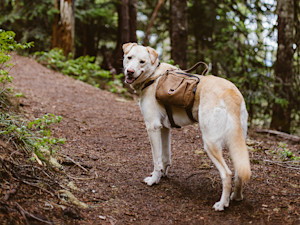Why Some Dogs Are Not Adept At Leash Untangling
Does your dog untangle themselves from a leash?

Share Article
There are two types of dogs in the world: dogs who become tangled in their leash and those who don’t. Tangled-up pups seem to have an easy-going approach to life — leash and all — while other dogs will stop in their tracks. Some dogs never learn to untangle themselves when the leash goes under one or more legs, even with efforts to teach them how to do this.
Safety is the main reason you should care about keeping the leash properly organized. It can be dangerous if the leash wraps completely around a leg, and a leash that is out of place can cause a dog to be off balance.
Why are some dogs unable to untangle themselves?
Problem Solving
Obviously, intelligence in the problem-solving area can play a role in which path a dog takes. But it’s far more complex than a simple question of brain power, with other factors being important, too.
Comfort
One big predictor of which dogs learn to extricate themselves when the leash has gone between their legs or wrapped around them is whether it makes them uncomfortable to have the leash there. Some dogs don’t seem to care if the leash is partially wrapped around a leg or if it touches their belly, so a twisted leash does not represent a problem. If it’s not a problem for a dog to have the leash out of place, then there is nothing to be fixed.

Interest
Some dogs are too interested in other things to focus on a tangled leash. If they are paying attention to the sights or smells on a walk, any issues with the leash may not be a top priority. Paying attention to other things may account for the dogs who sometimes choose to step over a leash purposefully and sometimes don’t bother; it depends on how exciting the walk is at the moment. Other dogs are always too intent on the sensory experiences during the walk to fuss over where the leash is.
Stop Leash Tangle
Here are a few ways to help your dog keep their leash untangled.
Choose a shorter leash
Teach your pup to walk by your side
Don’t use a retractable leash
If using a front harness clip, also attach it to the collar
Teach your dog to “fix it” by capturing the behavior with treats and praise when they do it themselves.

Karen B. London, PhD, CAAB, CPDT-KA
Karen B. London is a certified applied animal behaviorist (CAAB) and certified professional dog trainer (CPDT) who specializes in working with dogs with serious behavioral issues, including aggression. She has written for a variety of magazines including The Bark, Clean Run, and the APDT Chronicle of the Dog, and has published in scientific journals including Behavioral Ecology and Sociobiology, Ethology, Ecology, and Evolution, the Journal of Insect Behavior, and Insectes Sociaux. She is the author of seven books about dog training and canine behavior, including the forthcoming My Dog's Mystery Adventure: And Other Stories From a Canine Behaviorist and Dog Trainer.
Related articles
![Person with white blond hair and tattoos wearing a blue muscle t-shirt and white pants and a hands-free blue leash connected to a black shaggy haired dog]()
12 Leashes That Check Every Box on the Experts’ List
The dog leashes recommended by experts based on their very specific criteria.
![A happy lab wearing a backpack on a hiking trail.]()
Five Reasons My Dog Wears a Backpack
Wearing a backpack helped calm this reactive pup, and it could help yours too.
![Trendy woman in a green coat walking her cute dog in a white jacket in public]()
6 Reasons to Set Boundaries for Your Dog
Well-trained dogs have more freedom (and more fun).
![A woman cleaning up pee on the wood floors inside while disciplining a grey puppy with a raised finger of disapproval]()
10 Dog-Training Habits You Should Drop Right Now
Training a dog can seem pretty intuitive — until it’s not.




